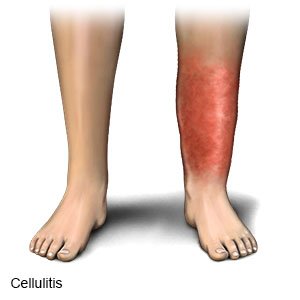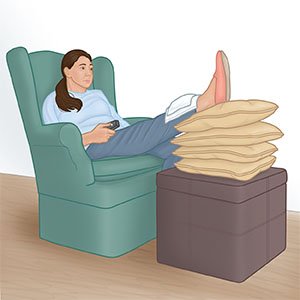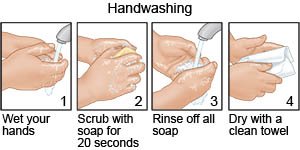Cellulitis
Medically reviewed by Drugs.com. Last updated on Apr 6, 2025.
Cellulitis is a skin infection caused by bacteria. Cellulitis is common and can become severe. Cellulitis usually appears on the lower legs. It can also appear on the arms, face, and other areas. Cellulitis develops when bacteria enter a crack or break in your skin, such as a scratch, bite, or cut.
 |
DISCHARGE INSTRUCTIONS:
Return to the emergency department if:
- Your wound gets larger and more painful.
- You feel a crackling under your skin when you touch it.
- You have purple dots or bumps on your skin, or you see bleeding under your skin.
- You see red streaks coming from the infected area.
Call your doctor if:
- The red, warm, swollen area gets larger.
- Your fever or pain does not go away or gets worse.
- The area does not get smaller after 3 days of antibiotics.
- You have questions or concerns about your condition or care.
Medicines:
You should start to see improvement in 3 days. If cellulitis is not treated, the infection can spread through your body and become life-threatening. You may need any of the following medicines:
- Antibiotics help treat a bacterial infection.
- Acetaminophen decreases pain and fever. It is available without a doctor's order. Ask how much to take and how often to take it. Follow directions. Read the labels of all other medicines you are using to see if they also contain acetaminophen, or ask your doctor or pharmacist. Acetaminophen can cause liver damage if not taken correctly.
- NSAIDs , such as ibuprofen, help decrease swelling, pain, and fever. This medicine is available with or without a doctor's order. NSAIDs can cause stomach bleeding or kidney problems in certain people. If you take blood thinner medicine, always ask your healthcare provider if NSAIDs are safe for you. Always read the medicine label and follow directions.
- Take your medicine as directed. Contact your healthcare provider if you think your medicine is not helping or if you have side effects. Tell your provider if you are allergic to any medicine. Keep a list of the medicines, vitamins, and herbs you take. Include the amounts, and when and why you take them. Bring the list or the pill bottles to follow-up visits. Carry your medicine list with you in case of an emergency.
Treatment options
The following list of medications are related to or used in the treatment of this condition.
Self-care:
- Wash the area with soap and water every day. Gently pat dry. Use bandages if directed by your healthcare provider.
- Apply cream or ointment as directed. These help protect the area. Most over-the-counter products, such as petroleum jelly, are good to use. Ask your healthcare provider about specific creams or ointments you should use.
- Place a cool, damp cloth on the area. Use clean cloths and clean water. You can do this as often as you need to. Cool, damp cloths may help decrease pain.
- Elevate the area above the level of your heart as often as you can. This will help decrease swelling and pain. Prop the area on pillows or blankets to keep it elevated comfortably.

Prevent cellulitis:
- Do not scratch bug bites or areas of injury. You increase your risk for cellulitis by scratching these areas.
- Do not share personal items, such as towels, clothing, and razors.
- Clean exercise equipment with germ-killing cleaner before and after you use it.
- Treat athlete's foot. This can help prevent the spread of a bacterial skin infection.
- Wash your hands often. Use soap and water. Wash your hands after you use the bathroom, change a child's diapers, or sneeze. Wash your hands before you prepare or eat food. Use lotion to prevent dry, cracked skin.

Follow up with your doctor within 3 days, or as directed:
He or she will check if your cellulitis is getting better. Write down your questions so you remember to ask them during your visits.
© Copyright Merative 2025 Information is for End User's use only and may not be sold, redistributed or otherwise used for commercial purposes.
The above information is an educational aid only. It is not intended as medical advice for individual conditions or treatments. Talk to your doctor, nurse or pharmacist before following any medical regimen to see if it is safe and effective for you.
Learn more about Cellulitis
- Can You Drink Alcohol with Antibiotics?
- Common Side Effects from Antibiotics, and Allergies and Reactions
Treatment options
Care guides
Symptoms and treatments
Further information
Always consult your healthcare provider to ensure the information displayed on this page applies to your personal circumstances.
